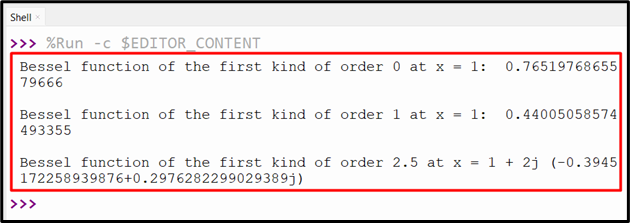Python is a popular and easy-to-learn programming language that can create software, websites, robots, and math functions. It uses object-oriented and high-performance features. Python has many libraries, such as “scipy”, that provide tools for machine learning, neural networks, and math operations. The “scipy’s Bessel function” solves differential equations with cylindrical or circular symmetry and wave propagation.
This Python tutorial presents an in-depth guide on “scipy’s Bessel function” using appropriate examples.
What are Bessel Functions?
“Bessel Functions” are a family of mathematical functions that are used to describe the behavior of waves and other oscillating systems. The specified functions are solutions to the Bessel differential equation, which is a 2nd-order linear differential equation with a complex variable. Bessel differential equations are shown below in their general form:
In the above equation, “v” is a complex number known as the order of the Bessel function.
Types of Bessel Functions
There are different types of Bessel functions, each with its own unique properties. Bessel functions include the following types:
- Regular Bessel functions: These are the most basic types of Bessel functions. They are denoted by “Jv(x)” and “Yv(x)”, where “v” is a complex number.
- Modified Bessel functions: These functions are similar to regular Bessel functions, but they have been modified to make them easier to work with numerically. They are denoted by “Iv(x)” and “Kv(x)”, where “v” is a complex number.
- Spherical Bessel functions: These functions are utilized to explain the behavior of waves on a sphere. They are denoted by “jn(x)” and “yn(x)”, where “n” is a positive number.
Using “scipy” to Calculate Bessel Functions
The “scipy” library provides a number of functions for calculating Bessel functions. Some of them are shown below:
- The most basic function is “special.jv(v, x)”, which calculates the regular Bessel function of the first kind of order “v” at the point “x”.
- The function “special.yv(v, x)” calculates the regular Bessel function of the second kind of order “v” at the point “x”.
- The function “special.iv(v, x)” calculates the modified Bessel function of the first kind of order “v” at the point “x”.
- The function “special.kv(v, x)” computes the modified Bessel function of the “2nd” kind of order “v” at the point “x”.
Example 1: Calculating a Bessel Function With “scipy”
Here is an example of how to calculate a Bessel function with “scipy”:
# Calculate the regular Bessel function of the “1st” kind of order “1” at point “2”
jv = sp.jv(1, 2)
print(jv)
In the above code, the “sp.jv()” function takes the order as a first argument and points at the second argument i.e., “point 2” to return the regular Bessel function accordingly.
Output
Based on the above snippet, the Bessel function has been calculated successfully.
Example 2: Calculating the Bessel Function of Different Kinds of Order
This example code computes the Bessel function of different kinds of order:
j1 = sp.jv(0, 1)
print('Bessel function of the first kind of order 0 at x = 1: ',j1)
j2 = sp.j1(1)
print('\nBessel function of the first kind of order 1 at x = 1: ', j2)
j3 = sp.jv(2.5, 1 + 2j)
print('\nBessel function of the first kind of order 2.5 at x = 1 + 2j',j3)
In the above code snippet, the “sp.jv()” and “sp.j1()” functions are used to calculate the Bessel function of various first kinds of order with a specified point value.
Output
This output implies that the Bessel function has been calculated successfully.
Conclusion
To calculate Bessel functions in Python using “scipy”, the “scipy.special.jv()” function can be used for the Bessel function of the first kind of real order and complex argument, or the “scipy.special.j1()” function can be utilized for the Bessel function of the first kind of order. The “scipy” library provides a number of functions for calculating Bessel functions, thereby making them easy to use in Python.


